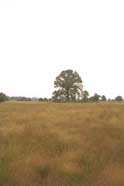

Illinois'
changing savannas
At the
time of Euro-American settlement, savannas were widespread on rich, loamy
soil, where frequent fires limited tree growth. Many of these savannas
later grew into forests after fire
suppression.
Other savannas occurred, in areas with poor, sandy soils and low moisture content that were burned by prairie fires. Because of the poor moisture and nutrient conditions of the soils, these savannas did not convert to woodland so rapidly. They are probably our best remaining examples of savanna vegetation.
Because there are no longer annual fires, the rich-soil savannas are nearly extinct. The scrubby trees that were fire-repressed have now grown much larger. Typically, grazing by domestic livestock has eliminated the shrubby understory, especially hazel, which the original land surveyors of the nineteenth century frequently reported.
How
are savannas different from barrens?
Savannas
are similar to barrens in that they have widely-spaced trees and an understory
of grasses. They differ from Illinois barrens in that they can occur on
poor to rich soils, whereas barrens almost always occur on thin, poor,
or excessively drained soils
|
|
Copyright © 2000 Illinois State Museum